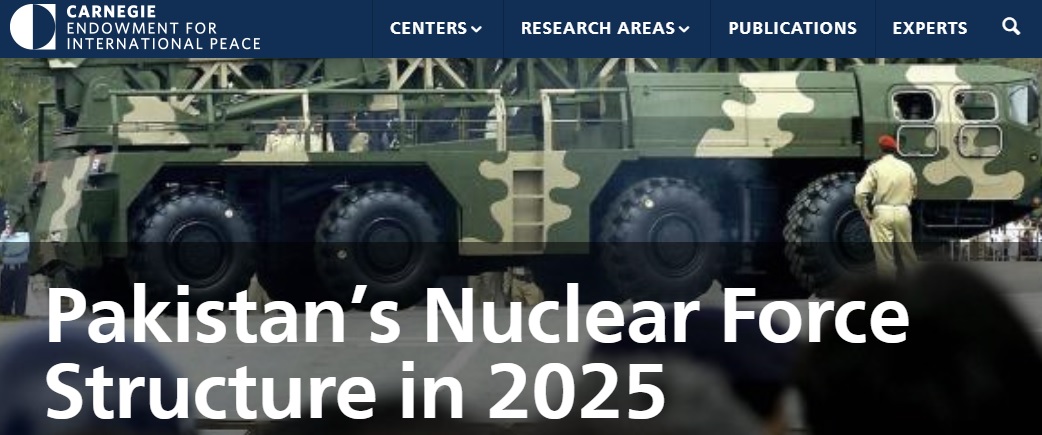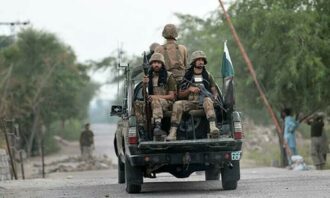Pakistan has the fastest growing arsenal in the world.1
Try Adsterra Earnings, it’s 100% Authentic to make money more and more.

This piece is part of a compilation bringing together Regional Voices on the Challenges of Nuclear Deterrence Stability in Southern Asia.
BACKGROUND
Pakistan’s nuclear posture and the size of Pakistan’s nuclear arsenal have been subjects of considerable speculation and debate since Pakistan first tested nuclear weapons, and increasingly so in recent years. Within the vast debate, however, many outside Pakistan seem to have agreed that Pakistan has the fastest growing arsenal in the world.1 Alarmists estimate that by 2025, Pakistan will become the third-largest nuclear weapon power, leapfrogging ahead of France, China, and the United Kingdom, behind only the United States and Russia.2 Others conjecture that its growth will make it only the fifth-largest arsenal.3 Even the best of these estimates are still highly speculative, based on assumptions about Pakistan’s goals, the capacity and efficiency of Pakistan’s nuclear materials production facilities, its ability to convert these materials into weapons components, and its ability to build an inventory of adequate numbers of delivery systems. Estimates also assume that 100 percent of available fissile material is being converted into weapons, and that Pakistan’s reprocessing and weapons core fabrication can keep pace with the production of plutonium at the Khushab nuclear complex. These estimates draw criticism and angry responses from Pakistani officials, but a vast majority of the people in Pakistan feel elated reading such reports. The people of Pakistan might be disappointed to learn that, contrary to the prevailing perceptions, the size of Pakistan’s arsenal is, and will remain, substantially smaller than recent reports published in the United States suggest.
So much agreement exists around incorrect estimates of Pakistan’s nuclear arsenal because of a paucity of primary source data. Most estimates rely on a few common sources, such as the Bulletin of Atomic Scientists, periodic reports by the International Panel on Fissile Materials (IPFM), the Stockholm International Peace Research Institute (SIPRI) yearbooks, assessments by the Institute of Science and International Security (ISIS), and occasional reports by the Federation of American Scientists (FAS) and the Nuclear Threat Initiative (NTI). These reports in turn rely on each other to corroborate their evaluations, which means that the same data are recycled repeatedly. The appearance of broad consensus comes from circular corroboration, not repeated independent verification. The resulting consensus picture shows Pakistan as a state obsessed with building as many nuclear weapons as it can in as short a time as possible, totally oblivious to the deleterious effects of such an undertaking on its economic health and the regional security environment. This picture, though inaccurate, affirms the suspicion with which Western observers have viewed Pakistan’s nuclear program since its inception. The Pakistani military’s predominant role in the management of the Pakistani nuclear program leads these same observers to perceive the Pakistani nuclear program as overly militaristic and aggressive in nature, while at the same time trusting that India’s program is moving at a leisurely pace, and that its growth is justifiable in light of the twin threat from China and Pakistan. Most observers tend to discount the weaponization potential of India’s enriched uranium stockpiles, which are simply put aside as fuel for India’s nuclear-powered submarines. They even fail to take into account reports emerging since 2012 about the construction of a large enrichment facility in Karnataka that would considerably increase India’s enriched uranium production capability and, in turn, its weapons fabrication capacity. The reality of Pakistan’s nuclear posture is quite different from this consensus perception.
Another factor that prevents statistical analyses from reflecting the true state of Pakistan’s nuclear program is the artful picking and choosing of data to support the conclusions at which one intends to arrive. Some very obvious facts are simply ignored because they are apparently not in conformity with the desired inferences. Although Pakistan, like India, has not made its inventory of fissile materials or warheads public, officials in Pakistan often comment on various studies and reports on the issue to call them inaccurate, exaggerated, or propagandistic. This publication will attempt to challenge some of the assumptions made by observers outside of Pakistan, and will try to provide an alternative and more realistic assessment of Pakistan’s current and future nuclear force structure within the constraints imposed by a lack of information in the public domain.
BEGINNINGS OF THE NUCLEAR DOCTRINAL DEBATE
Pakistan’s nuclear force structure is a consequence of the country’s nuclear doctrine. Tracing Pakistan’s doctrine over the last twenty years will, therefore, provide the context necessary to evaluate the veracity of Western estimates about the growth of Pakistan’s nuclear arsenal and will lay the groundwork for a more comprehensive understanding of Pakistan’s current and future force postures.
Prior to the overt demonstration of its nuclear capability in response to Indian nuclear tests in May 1998, Pakistan pursued a policy of ambiguity, denying the existence of a nuclear weapons program. This policy helped mitigate some of the international pressures, but by doing so it foreclosed the possibility of public discourse on Pakistan’s future nuclear doctrine. Even once the doctrine was outlined after the 1998 nuclear tests, Pakistan remained silent about the goals of its weapons program. Only after India announced its Draft Nuclear Doctrine in August 1999 did Pakistan’s government feel any serious pressure to publish its own doctrine. Three former government officials—foreign secretary Agha Shahi, air chief Zulfiqar Ali Khan, and foreign minister Abdul Sattar—jointly authored a newspaper article in October 1999 making the case for a minimum deterrence posture.4 They cautioned against squandering Pakistan’s limited economic resources to build an arsenal that exceeded Pakistan’s security needs, all in the name of winning a pointless competition against India. They advocated a posture that ruled out the possibility of nuclear warfighting on account of the large size and resource disparity between India and Pakistan, and argued that, since deterrence was the sole aim of the nuclear program, a small arsenal would suffice.5 Though the article was the first public statement on the nuclear program’s goals, the phrase most associated with Pakistan’s nuclear doctrine, “credible minimum deterrence,” never appears. Instead, the article recommended a minimalist approach in line with the common conception of “minimum deterrence,” while perhaps contradicting itself by insisting on the dynamic nature of the concept and opening up the possibility of an ever-expanding arsenal:
“Minimum deterrence has been and should continue to be the guiding principle of Pakistan’s nuclear pursuit. Of course minimum cannot be defined in static numbers. In the absence of mutual restraints, the size of Pakistan’s arsenal and its deployment pattern have to be adjusted, to ward off dangers of pre-emption and interception. Only then can deterrence remain efficacious.”6
The argument in support of minimum deterrence and a flexible force structure was reiterated by Abdul Sattar once he became foreign minister in the government of Pervez Musharaf. Indian decisionmakers adopted a similar approach, evident from former minister of external affairs Jaswant Singh’s argument that, as the security situation changes, the number of weapons required for minimum deterrence will also change.7 Eventually, both India and Pakistan added the word credible to their minimum deterrence postures, indicating their discomfort with the minimal size of their respective arsenals. According to nuclear policy expert Rodney Jones, “the term credible is a much more demanding criterion than ‘minimum’ deterrence might imply by itself.”8 The flexibility that “credible” provides effectively means that the nuclear doctrines of both India and Pakistan have allowed for reasonably large nuclear arsenals since the beginning of their respective nuclear programs.
PAKISTAN’S EVOLVING NUCLEAR POSTURE
Pakistan seeks to use its nuclear capability not only to counter the nuclear threat that India poses but its conventional advantage as well—Pakistan seeks a full spectrum minimum deterrence rather than merely nuclear deterrence. In the decade following the 1998 tests, Pakistan was able to achieve these objectives by maintaining a credible minimum deterrence posture through three major crises in 1999, 2001–2002, and 2008. Singh, India’s former external affairs minister, acknowledged the role of nuclear weapons in creating parity between India and Pakistan, stating at a forum that “the 1998 nuclear tests by India conferred a kind of parity to Pakistan that it had always sought.”9 While Pakistan’s nuclear capability buys a level of parity that Pakistan could not afford to create with conventional forces, the imperative to deter a broad spectrum of threats imposes more exacting demands on Pakistan’s nuclear deterrent posture and makes it sensitive to the changes in India’s conventional force structures and doctrines. This sensitivity explains Pakistan’s strong reaction to India’s Cold Start, or proactive operations, doctrine. As pointed out by Maleeha Lodhi, “Western analysts have often depicted this [Pakistan’s enhancement of its nuclear capability] as a mindless, irrational drive motivated by the unbridled ambitions of the nuclear scientific-military lobby.”10 Lodhi further argues that the issue of Pakistan’s nuclear arsenal cannot be divorced from its context, specifically “the chain of rapid developments that have undermined the region’s strategic equilibrium and affected Pakistan’s nuclear threshold.”11 Among these developments, she has listed the U.S.-India Civil Nuclear Agreement, the Nuclear Suppliers Group waiver obtained by India, the continuing growth of India’s conventional and strategic capabilities, India’s espousal of offensive warfighting doctrines such as the proactive operations doctrine, and concerted efforts to acquire a missile defense capability.12
In the aftermath of its overt nuclear tests in 1998, Pakistan set rather modest force goals in line with its policy of credible minimum deterrence, aiming for an arsenal of fewer than 100 weapons. In an often-quoted interview from January 2002, the director general of Pakistan’s Strategic Plans Division, Lieutenant General Khalid Kidwai, added constraints to the doctrine, stating that Pakistan had no plans “for now” to develop battlefield nuclear weapons such as nuclear artillery.13 Pakistan circa 2002 may not have felt any compelling operational need to develop tactical nuclear weapons (TNWs), but abstaining from TNWs could also have been a consequence of technological deficiencies, such as a dearth of fissile material or the inability to create suitably miniaturized warhead designs. Given the well-considered choice of a credible minimum deterrence posture, though, TNWs simply would not have made sense as part of Pakistan’s nuclear posture in the years immediately after 1998.
DICHOTOMY IN DECLARATORY AND OPERATIONAL POSTURES—RATIONALE AND RAMIFICATIONS
In 2011, tests of a short-range missile called the Nasr (Hatf-IX) came as a surprise to many, especially because an official press release announced that the 60-kilometer-range missile was capable of carrying “nuclear warheads of appropriate yield.”14 Introduction of the short-range, battlefield-usable weapons by Pakistan triggered an animated debate, both in Pakistan and abroad. Those with a sympathetic view of Pakistan’s position have argued that the Nasr is a logical response to India’s provocative Cold Start war doctrine.15 Senior Pakistani officials have been quoted as saying that the Nasris meant to pour cold water over Cold Start.16 Critics, on the other hand, view the Nasr as a destabilizing development that increases the probability of a nuclear war in South Asia.17 Debate aside, there is no doubt that Pakistan has embarked upon the development of battlefield nuclear weapons capability. Pakistani government spokespersons, though, continue to tout Pakistan’s policy of credible minimum deterrence, which is a form of the so-called simple punishment model of deterrence, unlike the deterrence by denial—or warfighting model of deterrence—enabled by the use of battlefield nuclear weapons. These models have very different demands in terms of the size of arsenals, command and control, and battlefield management. However, this apparent dichotomy in the declared doctrine and actual force posture has yet to be clarified by Pakistani strategic planners.
The pandemonium created by the short range of the Nasr weapon system and perception of problems related to maintaining effective centralized command and control, not to mention the physical security of the missile launchers once operationally deployed in the field, diverted public attention away from some very important implications.
More important than the much-discussed range of the missile is the accompanying development of a sleek and miniaturized warhead to be mounted on it. This technological achievement has far-reaching implications, since it will enable Pakistan to arm its Babur (surface-launched) and Raad (air-launched) cruise missiles with nuclear warheads. It will also make it possible for Pakistan to equip naval platforms with nuclear weapon systems. The debate around Pakistan’s introduction of battlefield nuclear weapons has also remained narrowly focused on the Nasr’s technical attributes, ignoring the operational characteristics of the other short-range systems, such as the 180-kilometer Abdali missile. Pakistan believes that the Nasr demonstrates a capability that will strengthen deterrence through option enhancement and threat manipulation. Lieutenant General (retired) Khalid Kidwai, speaking at the Carnegie International Nuclear Policy Conference in 2015, strongly criticized the narrow focus of the debate, stating that:
I strongly believe that by introducing the variety of tactical nuclear weapons in Pakistan’s inventory, and in the strategic stability debate, we have blocked the avenues for serious military operations by the other side. That the debate has been hi-jacked towards the lesser issues of command and control, and the possibility of their falling into wrong hands is unfortunate, because it has distracted and diverted attention from the real purpose of the TNWs, that of reinforcing deterrence, preventing war in South Asia, ensuring peace, thereby creating an enabling environment for politics and politicians to reassert and lead the way towards conflict resolution, and give South Asia and its people a chance.18
Without denigrating the arguments of the Nasr’scritics, one needs to look into the factors that compelled Pakistan to go down this treacherous path. India has been persistently challenging the credibility of Pakistan’s nuclear deterrent doctrinally, technologically, and practically. It has been insisting since February 2000 that there is a space below the nuclear threshold for a limited conventional war with Pakistan. Kidwai alluded to this, arguing that:
For 15 years I, and my colleagues, at the Strategic Plans Division in Pakistan, and worked for deterrence to be strengthened. . . . to create roadblocks in the path of those who thought that there was space for conventional war, despite the nuclear weapons of Pakistan. . . . what was probably encouraging them to find the space for conventional war, below this gap, was the absence of a complete spectrum of deterrence. . . . That there was some kind of a gap in their realization at the tactical level, and therefore it was leading to this encouragement . . . on the other side [in India] that there was space for conventional war. . . . Because war was being brought down under the Cold Start Doctrine to the tactical level. . . . Therefore, the idea of Nasr was born [out of the] need to plug this particular gap.19
Pakistan’s development and field testing of the Abdali (Hatf-II) and the Nasr (Hatf-IX) seem to be in keeping with the counsel given by Michael Quinlan, a highly respected British nuclear expert, who has argued that “The range of options available must, therefore, be an unmistakable continuum without huge gaps. That in turn meant that there had to be nuclear forces, backed by will and doctrine for their possible use, intermediate between conventional forces . . . and the ultimate strategic nuclear capability.”20 During the Cold War, NATO’s political and geographical compulsions along the central front in Germany, which constrained its ability to give up any space in a conflict even for sound operational reasons, forced it to adopt a forward defense posture. In contemporary South Asia, Pakistan faces a similar dilemma. Pakistan can justifiably draw a comparison between NATO’s compulsions and its own situation. It, therefore, feels compelled to promise a high probability of nuclear use in the event of a military conflict with India. Pakistan, thus, has all the basic building blocks of what it describes as full spectrum deterrence, and it is only a matter of time before missile systems, both at the shortest- and longest-range ends of the spectrum, will be available in sufficient numbers to put full spectrum deterrence into practice. However, not unlike the fluctuations in the U.S. nuclear posture between simple punishment and warfighting, Pakistan’s doctrinal evolution will not be linear.21
The transformation in Pakistan’s strategic posture has not been brought about merely by India’s continued quest to find a space for a limited conventional war. The prolonged commitment of almost one-third of Pakistan’s military forces in counterterror or counterinsurgency operations in the tribal areas along its borders with Afghanistan has thinned Pakistan’s deployments along the eastern border, creating a feeling of vulnerability that India can easily exploit. India has also adopted a belligerent posture along the Line of Control in Kashmir, especially across the working boundary in the Jammu-Sialkot sector. By perpetually keeping these borders hot and increasing the psychological pressure on Pakistan, India forces Pakistan toward greater reliance on its nuclear capability and lowering of its nuclear threshold.
Conceptually, credible minimum deterrence and full spectrum deterrence are different from each other in terms of both their goals and the force requirements necessary to achieve those goals. Whereas credible minimum deterrence is essentially a variety of simple punishment deterrence (with weapons mainly aimed at countervalue targets, and relatively limited force requirements), full spectrum deterrence is a kind of deterrence by denial, more akin to the flexible response or graduated response doctrines. Full spectrum deterrence targeting would include battlefield (counterforce) targets and would, therefore, require a larger arsenal size and a greater variety of both warheads and delivery systems. It would also require comparatively higher operational preparedness levels than the minimum credible deterrence posture. Pakistan’s resource constraints and the continued insistence by official spokespersons on credible minimum deterrence as the existing policy, though, likely mean that Pakistan may not go all the way to a fully operational nuclear warfighting posture or deterrence by denial, and may instead settle for something intermediate between the two postures in the next ten years.
Though Pakistan has the advantage of learning from other states, it is still too early for it to have found definitive answers to its nuclear dilemmas. The current situation should, therefore, be considered a transient phase in Pakistan’s evolving doctrinal thinking. It is also important to recognize that India and Pakistan are in a very close dyadic nuclear relationship and, given their historic rivalry dominated by the action-reaction syndrome it is obvious that one country cannot remain oblivious to the developments in the other.
The logic of dynamic and flexible deterrence that constantly adjusts to any expansion in the adversary’s arsenal seems contradictory to the common conception of minimum deterrence, and could lead India and Pakistan toward an unintended arms race. It also opens up the possibilities of an open-ended increase in the number of nuclear weapons held by both countries. Lieutenant General Kidwai, responding to a question during his 2015 Carnegie International Nuclear Policy Conference appearance, said that Pakistan had identified appropriate numbers to meet its minimum deterrence needs and these numbers were achieved in the recent past. However, the adoption of full spectrum deterrence, in response to the Cold Start doctrine, introduced a new dynamism in the program and led Pakistan to revise its estimates for the necessary numbers of weapons. Kidwai, however, reiterated that these revised numbers should suffice for the next ten to fifteen years, adding that “beyond a certain number you lose the logic, it’s not an open ended race.”22 This statement clearly indicates that Pakistan’s nuclear build-up has finite limits and is not likely to reach the level of the third-largest or even the fifth-largest nuclear power, as suggested by some analysts.
MYTH OF THE FASTEST GROWING NUCLEAR ARSENAL
Pakistan’s nuclear program has been stereotyped since its inception. It was first characterized as the so-called Islamic bomb. Then, after 9/11, it was dubbed the most insecure and vulnerable arsenal, just waiting to fall into the wrong hands. In the past few years, it has been commonly described as the fastest growing nuclear arsenal in the world. Given the scope of this publication, it is necessary to analyze only the last of these myths about the Pakistani nuclear arsenal. The five recognized nuclear weapon states (under the Non-Proliferation Treaty) ceased any further production of weapons-grade plutonium by 1995 and highly enriched uranium (HEU) by 1996. Consequent to the New START (Strategic Arms Reduction Treaty) agreement, the United States and Russia are maintaining slightly less than 1,600 operationally deployed strategic nuclear warheads each. The United Kingdom has reduced its arsenal to around 225 warheads and plans further cuts, while the number of Chinese and French weapons is stable at 250 and 300 weapons respectively. The Israeli nuclear weapons program remains shrouded in mystery—estimates of the size of its nuclear arsenal range from 80 to 200 warheads—and North Korea holds a small number of weapons. India and Pakistan are the only countries in the world still building up their nuclear arsenals and fissile material stockpiles. They are the only two countries currently engaged in a nuclear arms race—or, to be fair, in a nuclear arms competition.23
Neither India nor Pakistan has ever declared how many warheads they maintain, or how much fissile material they have. All the estimates found in various publications are speculative. Even the most professionally calculated quantities of fissile material make estimates based mainly on the capacities of the production facilities in the two countries, and are forced to make assumptions about many functional parameters. For instance, a 50-megawatt plutonium production reactor working at 100 percent capacity can produce 18.25 kilograms of plutonium per year. However, these plants normally run at a much lower capacity, and most calculations use a baseline of between 60 percent and 70 percent capacity. Running at this capacity, a 50-megawatt plant will produce around 11 to 13 kilograms per year, assuming that it can maintain the same efficiency through the entire 365 days. In practice, however, the plants may run as low as 40 percent to 50 percent capacity, producing up to 7 to 9 kilograms per year. Moreover, the reactors cannot run 365 days per year. Reactors shut down for refueling and routinely face technical snags, which are not accounted for in existing calculations. Calculating HEU production is even more complicated because analysts must guess the actual number of centrifuges in a particular plant, the enrichment capacity of each centrifuge (which is dependent on the diameter and height of each machine), the quality of the feed material, and whether the rotor is made of aluminum, maraging steel, or carbon fiber. None of these factors can be accurately estimated without intrusive inspections.24 Finally, it is hard to estimate what proportion of each country’s fissile material has been fabricated into warheads and what proportion is still being processed, or is being kept as reserve for future eventualities, including conversion into more weapon cores.
The amount of fissile material needed for a warhead is also a variable, dependent on the sophistication of weapon designs. The amount of fissile material per warhead that a given study assumes has a direct bearing on the bottom-line result for the estimated arsenal size that that study will find. For instance, the Global Fissile Material Report (GFMR) estimates that Pakistan currently possesses 170 kilograms of plutonium. If the GFMR assumed that Pakistan needed 6 kilograms of plutonium per weapon instead of 4 kilograms, it would make a significant difference in their final estimate; with 4 kilograms per warhead, the estimate would be 42 warheads, but with 6 kilograms per warhead, the estimate would drop to 28. The same clearly holds for HEU warheads; whether a Pakistani HEU-based warhead requires 15, 20, or 25 kilograms of HEU drastically changes the potential size of Pakistan’s arsenal. Compared to the thousands of nuclear tests conducted by great powers during the Cold War, India and Pakistan have only conducted six tests each. Neither has enough data to develop highly sophisticated weapon designs requiring lesser amounts of fissile material. It is, therefore, highly unlikely that the estimated size of Indian or Pakistani arsenals comport with reality. Another problem is that these studies, while categorizing India’s entire substantial stockpile of HEU as potential fuel for India’s nuclear-powered submarines, do not address Pakistan’s future HEU needs for naval propulsion. Pakistan is striving to develop the naval leg of its nuclear triad, which would ultimately include naval vessels propelled by nuclear fuel.
Leaving aside all the above-mentioned problems with methods for estimating nuclear arsenal sizes, data available from some of the more credible and widely quoted sources suggest that characterizing Pakistan’s nuclear force as the fastest growing arsenal in the world is totally unjustified.25 Data from the Bulletin of Atomic Scientists, SIPRI, and the GFMR clearly show that between 2007 and 2015, India and Pakistan’s arsenals grew at exactly the same number of warheads per year (see Tables 1–3). This alone should suffice to debunk the myth of the fastest growing arsenal in the world.
| Table 1 | ||
| Bulletin of Atomic Scientists – Estimates of Indian and Pakistani Nuclear Warheads | ||
| Year | India | Pakistan |
| 2007 | 50 | 60 |
| 2008 | 60 | 70 |
| 2009 | 70 | 80 |
| 2010 | 80 | 90 |
| 2011 | 90 | 100 |
| 2012 | 100 | 110 |
| 2013 | 110 | 120 |
| 2014 | 120 | 130 |
| 2015 | 110–120 | 110–130 |
| “Pakistani Nuclear Forces, 2015,” Bulletin of the Atomic Scientists 71, no. 6 (November 2015): 59–66. | ||
| Table 2 | ||
| SIPRI Estimates of Indian & Pakistani Nuclear Warheads | ||
| Year | India | Pakistan |
| 2010 | 60–80 | 70–90 |
| 2011 | 70–90 | 80–100 |
| 2012 | 80–100 | 90–110 |
| 2013 | 90–110 | 100–120 |
| 2014 | 90–110 | 100–120 |
| 2015 | 90–110 | 100–120 |
| Data from SIPRI Yearbooks 2010–2015. See, for example, Stockholm International Peace Research Institute, SIPRI Yearbook 2015: Armaments, Disarmament and International Security (Oxford: Oxford University Press, 2015). | ||
| Table 3 | ||
| Global Fissile Materials Report (GFMR) Estimates of Indian & Pakistani Nuclear Warheads | ||
| Year | India | Pakistan |
| 2007 | 50 | 60 |
| 2009 | 60-70 | 70-90 |
| 2011 | 80-100 | 90-110 |
| 2013 | 90-110 | 100-120 |
| International Panel on Fissile Materials, Global Fissile Materials Report 2007 (Princeton, NJ: International Panel on Fissile Materials, 2007). | ||
ANOMALIES IN THE AVAILABLE ESTIMATES
Table 4 below provides estimates of the fissile material stockpiles of India and Pakistan. This table provides a confusing picture at best. For instance, India’s military plutonium stocks grew from 0.52 metric tons in 2007 to 0.7 metric tons in 2009, but were back to 0.52 metric tons in 2011. In the same time period, the non-military plutonium stocks declared strategic (rather than civilian) by India rose from 5.4 metric tons in 2007 to 6.8 metric tons in 2009, before declining again in 2011 to 4.2 metric tons. Pakistan’s plutonium stocks show a steady growth between 2007 and 2015. However, Pakistani HEU stocks jumped from 1.3 metric tons in 2007 to 2.1 metric tons in 2009, and then grew more modestly to 2.7 metric tons in 2011 and 3.0 metric tons in 2013. These stocks grew to 3.1 metric tons by 2015. Throughout this period, there was no evidence of new enrichment plants or facilities to produce feed material for these plants. It is hard to imagine that India’s output of HEU could increase so rapidly without new infrastructure. Yet, India’s HEU stocks seem to have grown exponentially from 0.2 metric tons in 2007 to 3.2 metric tons in 2015. The GFMR authors do not explain these substantive fluctuations in estimates.
Another important statistic that receives too little attention is the comparative size of Indian and Pakistani HEU inventories. According to the 2015 International Panel on Fissile Materials (IPFM) report, India has 3.2 metric tons of HEU compared to Pakistan’s 3.1 metric tons. Pakistan’s nuclear weapons program was based entirely on HEU until 1999, when the first plutonium production reactor at Khushab became operational. India’s program has been plutonium-based since its inception. There is a common tendency to ignore India’s HEU stocks while estimating India’s nuclear weapons potential, under the assumption that India’s HEU stocks are meant for naval propulsion. A stockpile of 3.2 metric tons, though, is far more than India’s naval nuclear reactors could possibly use. Each submarine, for example, requires a fuel load of only 200 kilograms of 30 percent enriched uranium. Though India has no real need for more HEU, the rare materials plant (RMP) at Rattehali near Mysore is continuing to churn out more. In short, India has a large surplus of HEU available for making nuclear warheads, and, therefore, the ability to grow its arsenal much faster than Pakistan.
It is also worth mentioning how large the margins of error are for estimates of India and Pakistan’s fissile material stockpiles. Pakistan’s HEU inventory, for example, is estimated at 3 metric tons with a probable error of (+ 1.2 metric tons). The actual amount could be anywhere from 1.8 metric tons to 4.2 metric tons. To put the margin of error in terms of weapons, a range of 1.8 metric tons to 4.2 metric tons is a range of 60 20-kilogram warheads. Given that the available data have such serious shortcomings, no one can declare with any degree of certainty that Pakistan will become the third- or fifth-largest nuclear power in the world, or ascribe adjectives like “fastest growing” with any authority. Such unrealistic inferences drawn from suspect data lead to erroneous conclusions and poor predictions of the strategic environment likely to prevail a decade from now.
| Table: 426 | ||
| Global Fissile Material Report – Estimates of Indian & Pakistani Fissile Material Stocks | ||
| Year | India | Pakistan |
| 2007 | Plutonium: 0.52 metric tons (5.4 metric tons, Strategic) HEU: 0.2 metric tons |
Plutonium: 0.064 metric tons HE : 1.3 metric tons |
| 2009 | Plutonium: 0.7 MT (6.8 metric tons, Strategic) HEU : 0.6 metric tons |
Plutonium: 0.1 metric tons HE : 2.1 metric tons |
| 2011 | Plutonium: 0.52 metric tons (4.2 metric tons, Strategic) HEU: 2.0 MT |
Plutonium: 0.14 metric tons HEU: 2.7 metric tons |
| 2013 | Plutonium: 0.54 metric tons (4.7 metric tons, Strategic) (0.24 metric tons, Civilian) HEU: 2.4 metric tons |
Plutonium: 0.15 metric tons HEU: 3 MT (+ 1.2) |
| 2015 | Plutonium: 0.59 metric tons (3.4 metric tons, Strategic) (0.2 metric tons, Civilian) HEU: 3.2 metric tons |
Plutonium: 0.17 metric tons HEU: 3.1 metric tons |
A REALISTIC APPRAISAL OF PAKISTAN’S PROSPECTIVE NUCLEAR FORCE STRUCTURE IN 2025
No official figures for Pakistan’s fissile material stockpiles or weapons inventory have ever been released by the government of Pakistan, and no authentic information is available in the public domain about the size and capacity of Pakistan’s fissile material production plants. Despite the paucity of information, a reasonable estimate can be created from data that exist once important considerations, such as the economic and industrial capacity, availability of requisite raw materials, doctrine, posture, and politico-diplomatic and strategic compulsions, are accounted for.
Hans M. Kristensen and Robert S. Norris, in their latest report for the Bulletin of Atomic Scientists, estimate the Pakistani nuclear stockpile at between 110 and130 warheads, whereas the Arms Control Association’s fact sheet estimates 110 warheads. The median figure is 120 warheads. Pakistan’s capacity to produce HEU-based warheads is usually estimated to be about four weapons per year and, therefore, it could produce around 40 additional HEU-based warheads over the next decade. Currently, Pakistan has four operational plutonium production reactors at its Khushab complex. Assuming the reactors run at 60 percent capacity, each would produce slightly less than two weapons’ worth of plutonium per year, toward a total output of around 36 kilograms of plutonium—six warheads at 6 kilograms per warhead—per year. This suggests that Pakistan could produce up to 60 plutonium warheads over the next decade. The gross total of warheads by 2025, both plutonium- and HEU-based, should be 220, based on available unofficial estimates: 120 warheads in the current arsenal, plus 100 additional warheads. Kristensen and Norris have likewise estimated the size of Pakistan’s arsenal in 2025 to be between 220 and 250 warheads.
Arriving at these figures entails making a number of assumptions about the number and capacity of Pakistan’s centrifuges; the efficiency of Pakistani plutonium production reactors; their uninterrupted operation throughout the year; the amount of HEU and plutonium needed for each warhead; Pakistan’s requirements for naval propulsion; whether Pakistan has been and will continue to convert all of the available material into warheads or maintain some reserve of fissile materials outside warheads; whether Pakistan has determined an upper figure for the size of its arsenal; and Pakistan’s capacity to produce and stockpile requisite delivery systems for all these warheads. Finally, these estimates all assume that Pakistan will continue to produce fissile materials until 2025, rather than ceasing production somewhere in the near future, having satisfied its operational needs.
Pakistan’s nuclear forces in 2025 will have a wide variety of delivery systems for full spectrum deterrence but will, in all probability, comprise fewer than 200 warheads made from both HEU and plutonium, with a wide range of yields, all the way from low-yield to (potentially) boosted fission devices. Pakistan’s delivery systems will likely be a mix of solid-fueled surface-to-surface ballistic missiles with short and medium ranges, ground- and air-launched cruise missiles—some of which may be deployed on surface naval vessels and submarines—gravity bombs delivered by appropriate aerial platforms, and maybe indigenously developed nuclear-powered submarines. Pakistan likely will not keep building its nuclear arsenal for an indefinite period, given its economic constraints and comparatively modest nuclear force requirements—its deterrence is focused on India and is not meant to seek regional or global power status. The availability of delivery systems might also be a limiting factor for the size of Pakistan’s nuclear arsenal.
Since 2010, Pakistan has carried out the Azm-i-Nau (New Resolve) series of military exercises to test changes made to meet the challenge posed by India’s Cold Start doctrine. These exercises have proved that Pakistan could effectively counter Cold Start–type operations with conventional forces. However, as the gap between Indian and Pakistani conventional forces continues to widen in India’s favor, and as Pakistan remains engaged in prolonged counterterrorism operations in various parts of the country, the Pakistan Army’s conventional response to Cold Start may not be sufficient in the future. Introducing a short-range battlefield nuclear weapon system like the Nasr provides reassurance in case conventional deterrence fails or India embarks on an adventurist policy, as suggested by some Indian cabinet ministers in the aftermath of an Indian special forces operation in Myanmar. Weapons like the Nasr have enhanced Pakistan’s options and complicated Indian calculations for conventional military incursions into Pakistan. Indian planners cannot ignore battlefield nuclear weapons, despite the dismissive attitude displayed by former chairman of India’s National Security Advisory Board Shyam Saran and other Indian security analysts. Pakistan’s nuclear forces will maintain their present configuration to cover the whole spectrum of threats with a variety of nuclear warheads and delivery systems in the foreseeable future, barring drastic changes in the overall security environment or a major improvement in India-Pakistan relations.
CONCLUSION
Pakistan’s nuclear arsenal will grow in the short term, but that growth will not be unbridled and will certainly be far less than suggested in some recent studies.27 Pakistan will likely maintain its current inventory of solid fueled missiles: the Ghaznavi (Hatf-III), various versions of the Shaheen-1 (Hatf-V), the Shaheen-2 (Hatf-VI), the cruise missile Babur (Hatf-VII), the air-delivered cruise missile Raad (Hatf-VIII), and the Shaheen-3 (Hatf-X), plus short-range missiles like the Nasr (Hatf-IX) and some improved version of the Abdali (Hatf-II). It is possible that the liquid-fueled Ghauri (Hatf-IV) will be retired from service by 2025.
Contrary to the specter that full spectrum deterrence—an unfamiliar term in nuclear jargon—necessitates a very large arsenal, Pakistan’s full spectrum deterrence arsenal will be modest in size, albeit with a wide variety of delivery systems, including short- and medium-range ballistic missiles, cruise missiles, and aircraft delivery systems. One can also not rule out the possibility of a significant improvement in India-Pakistan relations, which would mitigate the incentives and pressures for Pakistan to build and maintain a larger arsenal.
Brigadier Naeem Salik (retired) is a senior fellow at the Center for International Strategic Studies. Before his retirement from the Pakistani military, he served as director of arms control and disarmament affairs in the Strategic Plans Division, the secretariat of Pakistan’s National Command Authority.
NOTES
1 Hassan Khan, “Pakistan Has Fastest Growing Nuclear Weapons Programme in the World: Report,” Express Tribune, November 24, 2014.
2 Tim Craig, “Report: Pakistan’s Nuclear Arsenal Could Become the World’s Third-Biggest,” Washington Post, August 27, 2015.
3 Rishi Iyengar, “Pakistan Will be World’s Fifth Largest Nuclear Power by 2025,” Times,October 22, 2015. Hans Kristensen and Robert Norris also estimate that Pakistan’s arsenal would be the fifth largest in the world by 2025, see Hans M. Kristensen and Robert S. Norris, “Pakistani Nuclear Forces, 2015,” Bulletin of the Atomic Scientists 71, no. 6 (November 2015): 59–66.
4 Based on the timing of the publication of the article, Michael Krepon has argued that it was in response to India’s Draft Nuclear Doctrine. See Michael Krepon, Pakistan’s Nuclear Strategy and Deterrence Stability (Washington, DC: Stimson Center, 2012), 8, http://www.stimson.org/images/uploads/research-pdfs/Krepon_-_Pakistan_Nuclear_Strategy_and_Deterrence_Stability.pdf.
5Agha Shahi, Zulfiqar Khan, and Abdul Sattar, “Securing Nuclear Peace,” News International, October 5, 1999.
6 Ibid.
7 Jaswant Singh stated that, “Minimum deterrence is not quantification. It is not a fixity. It is the enunciation of a fixity. The principle is codified in cold war phraseology. It is to be determined in accordance with the reality of an assessment of the security situation. And as the security situation alters with time determination of minimum deterrence also alters.” “An Interview with Shri Jaswant Singh, Minister for External Affairs,” India Today, January 11, 1999.
8 Rodney W. Jones, Minimum Nuclear Deterrence Postures in South Asia: An Overview, (Washington, DC: Defense Threat Reduction Agency, Advanced Systems and Concepts Office, October 1, 2001), 3.
9 “1998 Nuclear Tests Gave Parity to Pakistan: Jaswant Singh,” Press Trust of India, November 28, 2010, http://www.dnaindia.com/india/report_1998-nuclear-tests-gave-parity-to-pakistan-jaswant-singh_1473590-all.
10 Maleeha Lodhi, “Pakistan’s Nuclear Compulsions,” News International, November 6, 2012.
11 Ibid.
12 Ibid.
13 Paulo Cotta Ramusino and Maurizio Martellini, Nuclear Safety, Nuclear Stability and Nuclear Strategy in Pakistan: A Concise Report of a Visit By Landau Network – Centro Volta, (Como, Italy: Landau Network – Centro Volta, January 2002).
14 “No. PR94/2011-ISPR,” press release, Inter Services Public Relations, April 19, 2011, http://www.ispr.gov.pk/front/main.asp?o=t-press_release&id=1721.
15 Rodney W. Jones, “Pakistan’s Answer to Cold Start?,” Friday Times, May 13, 2011; Mansoor Ahmed, “Why Pakistan Needs Tactical Nuclear Weapons,” Weekly Pulse, May 6, 2011.
16 Feroz Khan, Eating Grass: The Making of the Pakistani Bomb (Stanford, CA: Stanford University Press, 2012), 396.
17For a balanced view, see Jones, “Pakistan’s Answer to Cold Start?”; for a critical view, see Ejaz Haider, “Stupidity Goes Nuclear,” Express Tribune, April 26, 2011.
18 “A Conversation with Gen. Khalid Kidwai” (transcript from the Carnegie International Nuclear Policy Conference, Washington, DC, March 23, 2015), Carnegie Endowment for International Peace, http://carnegieendowment.org/files/03-230315carnegieKIDWAI.pdf.
19 Ibid.
20 Michael Quinlan, Thinking About Nuclear Weapons – Principles, Problems, Prospects (Oxford: Oxford University Press, 2009), 36.
21 The US strategy evolved from Massive Retaliation to Flexible Response to Assured Destruction to Limited Nuclear Options to Countervailing and then to the Prevailing Strategy partly due to changing security environment and partly due to technological advancements.
22 “Gen. Khalid Kidwai,” Carnegie Endowment for International Peace.
23 The United States has, for instance, reduced the number of its operational nuclear warheads to 1,900 but continues to undertake qualitative upgrades for these warheads. See “Fact Sheets & Briefs: U.S. Nuclear Modernization Programs,” Arms Control Association, January 16, 2014, https://www.armscontrol.org/factsheets/USNuclearModernization; and Eugene Miasnikov, Matthew Kroenig, and Lu Yin, “Modernizing Nuclear Arsenals: Whether and How,” Bulletin of the Atomic Scientists, 2015, http://thebulletin.org/modernizing-nuclear-arsenals-whether-and-how7881 for details of the ongoing and planned modernization programs in the United States and the Russian Federation.
24 GFMR 2013 acknowledges this fact stating that, “Estimates are limited by the uncertainty about Pakistan’s enrichment capacity, and the operating history of its centrifuge plant at Kahuta and possibly a second plant that reportedly exists at Gadwal.” International Panel on Fissile Materials, Global Fissile Materials Report 2013: Increasing Transparency of Nuclear Warhead and Fissile Material Stocks as a Step toward Disarmament (Princeton, NJ: International Panel on Fissile Materials, 2013), 14.
25 Hans M. Kristensen and Robert S. Norris have suggested that, “Speculation that Pakistan may become the world’s third largest nuclear weapon state – with a stockpile of some 350 warheads a decade from now – are, we believe, exaggerated because that would require a buildup of two to three times faster than growth over the past two decades. Pakistan simply doesn’t have the industrial capacity to develop, produce and deploy that many additional nuclear weapon systems in a decade.” See Kristensen and Norris, “Pakistani Nuclear Forces, 2015.”
26 Ibid.
27 See for instance, Toby Dalton and Michael Krepon, A Normal Nuclear Pakistan (Washington, DC: Stimson Center and Carnegie Endowment for International Peace, 2015).
Published By

Latest entries
 Slottica Přihlášení Android Ios - 2502025.01.21Slottica Casino App Apostas Esportivas E Muito
Slottica Přihlášení Android Ios - 2502025.01.21Slottica Casino App Apostas Esportivas E Muito Slottica Přihlášení Android Ios - 2502025.01.21Slottica Sport Melhores Casas
Slottica Přihlášení Android Ios - 2502025.01.21Slottica Sport Melhores Casas Slottica Přihlášení Android Ios - 2502025.01.21Slottica Aplikacja Android Nossa Newsletter
Slottica Přihlášení Android Ios - 2502025.01.21Slottica Aplikacja Android Nossa Newsletter Slottica Přihlášení Android Ios - 2502025.01.21Slottica Kasyno Bonus Bez Depozytu Seu Bônus
Slottica Přihlášení Android Ios - 2502025.01.21Slottica Kasyno Bonus Bez Depozytu Seu Bônus






